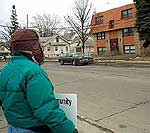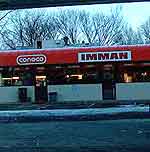By Brandt Williams
Minnesota Public Radio
March 19, 2002
|
| RealAudio |
Serious crime in Minneapolis has declined over the last several years. However, open-air drug selling is still a problem in some parts of the city. Police and neighborhood activists are trying to get rid of drug dealers. But when they crack down on drug dealers in one area, the dealers just move somewhere else. Some say the best way to completely rid these areas of drug-related crime is to bring in more police and social service agencies. But others say the ultimate solution will come from the people who live there.
| |
|
|
|
||
For nearly a 10-block stretch along 26th St. in north Minneapolis, groups of young black men can be seen hanging out on street corners.
Not all of them are dealing drugs. But those who are, signal to passing motorists by putting their fingers to their mouths as if they are smoking cigarettes.
Money is exchanged for drugs quickly, and in broad daylight. The buyer pulls over and the exchange is made through an open car window.
Some residents of this area have resorted to direct confrontation in an attempt to get rid of them.
"We don't want you dealing drugs in our neighborhood! You disrespect everyone in this neighborhood!" yells resident Dennis Wagner.
On the corner of 26th St. and Knox, Wagner chases off a drug dealer who's in the middle of a curbside transaction.
The young man is making his deal right across the street from where Wagner and 10 of his neighbors are holding an anti-crime demonstration. The young African-American teenager looks surprised by the confrontation, and runs into a nearby apartment building.
The neighbors have been holding these vigils once a week for the last several months.
"We're putting pressure on here so they're going to go to the place of least resistance. And I hear the drug dealing is a lot worse in other areas," says Wagner.
Dennis Wagner and his wife Deborah have lived in the neighborhood for almost 18 years. Deborah is a real estate agent and a board member of the neighborhood council.
| |
|
|
|
||
She says there's a way to predict which areas of the city are bound to see increases in crime. Deborah says drug dealers and other criminals will go to neighborhoods where residents are too old, or too scared, to fight back.
"As those folks move out and make room for younger people with energy - who want to invest their time and effort and money into this neighborhood - things will definitely get better," says Deborah Wagner.
The Wagners and their neighbors say they are seeing an increased police presence in the area, and they're encouraged by that. Police squad cars can be seen frequently patrolling 26th St. and the adjacent avenues.
The drug dealers disappear whenever police cars drive down the street, but they don't go away.
"Whenever we do a lot of police action to get with drug dealers, it's like a balloon - you squeeze it in one area and it pops out in the other," says Minneapolis Police Lt. Marie Pryznski, who is in charge of this sector.
"Over the course of a year we've put a lot of additional resources into the area...and we have seen the results of that," says Pryznski. "I'm not saying drug dealing has gone away, but it has been really suppressed, and we have seen it pop up in other areas."
Kris Nelson stands at the corner of 26th and Penn.
He is kitty-corner from a convenience store and gas station which the City Council recently identified as a magnet for drug dealers. In February, they voted to revoke its license, and it was shut down on March 11.
Nelson is with the University of Minnesota's Center for Urban and Regional Affairs. He says city and neighborhood groups play a role in combatting poor housing, crime and poverty. However, Nelson says concerned citizens like the Wagners play the largest role in revitalizing a neighborhood.
"Citizens represent a constituency for public officials and agency staff to really respond to it. And through that partnership things can change and do change," says Nelson. "It takes a lot of time and effort, but that's the only way things change. People from the outside can't come in and save your neighborhood. People in the neighborhood have to do that."
Nelson says several inner-city Minneapolis neighborhoods once known for rampant crime, like Powderhorn and parts of Phillips, are on the rebound. And he credits the city's active citizenry for the turnaround.
More from MPRMore Information


